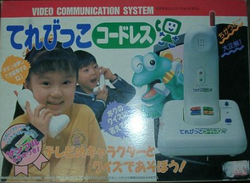Sanrio Wiki has moved from ShoutWiki. Account creation is closed to prevent spam on a company typically seen in the West for its children's media. If you want an account here (or to activate your old ShoutWiki account here) it is suggested (though you have free will) get your parent/guardian's permission to use the Internet, and contact EvieMelody (X, formally Twitter) re: account creation or article requests.
Note: Sanrio Wiki is not official and is not run by Sanrio Co., Ltd. or related parties. This wiki uses some low resolution content (images, short sound clips) to describe articles, under fair use (for the purpose of illustrating and describing an article only). All rights are reserved by Sanrio and related parties.
Sometimes this wiki may be a little slow, other times it is faster. This is likely server related. On such days, you may want to stockpile edits offline for later.
See also: Sanrio Wiki:COPPA
Terebikko

The Terebikko (Japanese: てれびっこ) is a VHS console game system by Bandai, released in 1988.[1] It is officially known as a "Video Communication System". It is shaped like a toy phone with four coloured buttons 1 through 4 (in red, blue, green, yellow) and was targeted towards young children.
In 1989, Mattel rebranded it for the United States as the See 'n Say Video Phone based on their 1964 educational toy See 'n Say. Unlike the original Terebiko, the See 'n Say Video Phone games didn't have the existing powerful character licenses like Hello Kitty and Mario attached to its releases and mixed puppetry with animation without licensed characters. The puppetry involved a main character called Saymour[2] from the See 'N Say Phone Center and his friends such as computers Tululu and Tidas, as well as Bee, The Farmer, and Mother Goose.[3]
There is also a variation of the Terebikko called the Terebikko Cordless (Japanese: てれびっこコードレス) (copyright 1994).[4]
Games relevant to Sanrio
- Hello Kitty no Tanoshii Okaimono (No. 8 in Terebikko's exclusive VHS Tape series)
- Kerokerokeroppi no Issho ni Asobou
Gameplay
Players connect the Terebikko to the TV's audio output jack. While watching the video, the player is called by a character on the screen and has to answer a question with the telephone. The Terebikko can then use signals from the video for interaction if the answer was a good or bad choice.
External links
References
- ↑ (Dead link)【懐かしいCM】てれびっこ バンダイ BANDAI(1988)|Japan TV commercial Retrieved August 21, 2017 from Terebikko Wikipedia article citation
- ↑ Advertisement from unknown publication (via Pinterest)
- ↑ "The Mattel See 'N Say Video Phone - VHS toy from 1988" thread by tropesaredangerous (Forums - The Lost Media Wiki)
- ↑ Terebikko Dragon Ball - Kami Sama Explorer